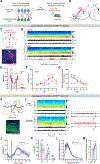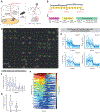Sleep need-dependent plasticity of a thalamic circuit promotes homeostatic recovery sleep
- PMID: 40536979
- PMCID: PMC12315381
- DOI: 10.1126/science.adm8203
Sleep need-dependent plasticity of a thalamic circuit promotes homeostatic recovery sleep
Abstract
Prolonged wakefulness leads to persistent, deep recovery sleep (RS). However, the neuronal circuits that mediate this process remain elusive. From a circuit screen in mice, we identified a group of thalamic nucleus reuniens (RE) neurons activated during sleep deprivation (SD) and required for sleep homeostasis. Optogenetic activation of RE neurons leads to an unusual phenotype: presleep behaviors (grooming and nest organizing) followed by prolonged, intense sleep that resembles RS. Inhibiting RE activity during SD impairs subsequent RS, which suggests that these neurons signal sleep need. RE neurons act upstream of sleep-promoting zona incerta cells, and SD triggers plasticity of this circuit to strengthen their connectivity. These findings reveal a circuit mechanism by which sleep need transforms the functional coupling of a sleep circuit to promote persistent, deep sleep.
Conflict of interest statement
Figures








References
-
- Borbely AA, A two process model of sleep regulation. Hum Neurobiol 1, 195–204 (1982). - PubMed
-
- Deboer T, Behavioral and electrophysiological correlates of sleep and sleep homeostasis. Curr Top Behav Neurosci 25, 1–24 (2015). - PubMed
-
- Benington JH, Heller HC, Restoration of brain energy metabolism as the function of sleep. Prog Neurobiol 45, 347–360 (1995). - PubMed
-
- Ishimori K, True cause of sleep: a hypnogenic substance as evidenced in the brain of sleep-deprived animals. Tokyo Igakkai Zasshi 23, (1909).
MeSH terms
Grants and funding
LinkOut - more resources
Full Text Sources
Molecular Biology Databases

